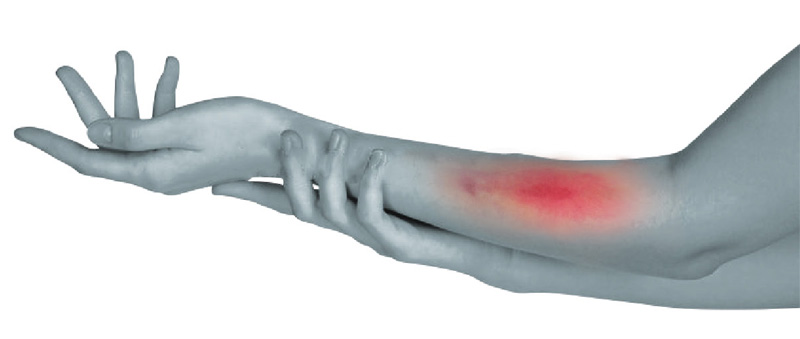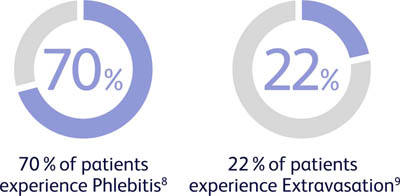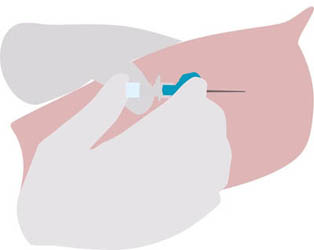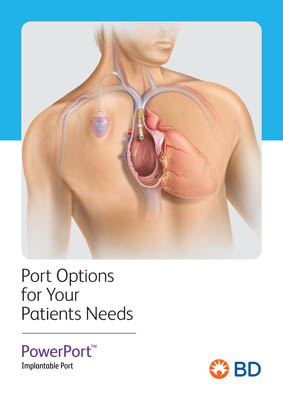
Chemotherapy is a complex and exhausting process.
As patients are the ones who go through the process, it is important to help them to have a better life. We aim to help them lead a near
normal life by making their therapy more comfortable.
Patient Experience with ChemoPorts

The need for vein preservation
Vascular access is an important aspect that allows patients to provide blood samples and receive blood transfusions, fluids, and medications. 4,5,6
Planning for vascular access should :
- Include selection of the most appropriate VAD5
- Minimize vessel harm5
- Preserve veins for future medical needs5


of patients who receive chemotherapy through a Peripheral Intravenous Catheters (PIVC) were unable to complete their therapy, most often due to inadequate vasculature.7
Impact of Vesicant & Irritant Drugs:
Among patients receiving vesicant/
irritant chemotherapy


Difficult Venous Access (DiVA):
1 out of every 3-patients undergoing
chemotherapy has DiVA11


Lower rate
of adverse
events -
Ports (1.4%),
PIVCs (42.3%)12

Significantly fewer
failures# with
Ports
versus PIVCs
(3.4% vs 26.7%)12

43% of patients
converted to ports
due to multiple PIVC
failures and lack of
vascular access12

Ports were associated
with significantly fewer
complications compared
with Peripherally Inserted
Central Catheters
(PICCs)13

Rates of infection,
thrombosis and
mechanical
issues,
were found to be,
lower with Ports vs ,
PICCs13

Fewer patients experienced
one or more complications$
in the Ports arm versus the
Centrally Inserted Central
Catheter (CICC) arm
(38% vs 54%)14

Lower rate
of adverse
events -
Ports (1.4%),
PIVCs (42.3%)12

Significantly fewer
failures# with
Ports
versus PIVCs
(3.4% vs 26.7%)12

Significantly fewer
failures# with
Ports
versus PIVCs
(3.4% vs 26.7%)12

Ports were associated
with significantly fewer
complications compared
with Peripherally Inserted
Central Catheters
(PICCs)13

Rates of infection,
thrombosis and
mechanical
issues,
were found to be,
lower with Ports vs ,
PICCs13

Fewer patients experienced
one or more complications$
in the Ports arm versus the
Centrally Inserted Central
Catheter (CICC) arm
(38% vs 54%)14
Vesicant drugs cause extravasation, which further damages the surrounding tissues.
The port reduces the risk of extravasation significantly and are thus recommended15

Reduces the
risk
of
extravasation15

Secured placement
and lowers the rate
of infection13

Improves quality
of life1

Reduces the risk
of thrombosis13

Does not obstruct
daily life3

Lowers the rate of
adverse events12

Reduces the
need for
repeated
venipuncutre4

Only monthly
flushing needed4

Reduces the
risk
of extravasation15

Secured placement
and lowers the rate
of infection13

Improves quality
of life1

Reduces the risk
of thrombosis13

Does not obstruct
daily life3

Lowers the rate of
adverse events12

Reduces the
need for
repeated
venipuncutre4

Only monthly
flushing needed4
Watch the video
for a detailed insertion demonstration
of a ChemoPort*
Criteria for selection of an appropriate VAD
The selection of an appropriate VAD should take into consideration the duration and type of therapy, frequency of access,
required care and maintenance as well as the VAD benefits and limitations
Download BD PowerPortTM brochure now!

aNon-vesicant: does not directly produce tissue damage when inadvertently delivered into tissues surrounding the vasculature, but may indirectly cause injury from compression of tissues by fluid volume.
bVesicant: an agent capable of causing tissue damage upon escaping vasculature into surrounding tissue.
cIrritant: an agent with potential to cause discomfort or pain at the injection site or in the vessel lumen and may be accompanied by inflammation.
dFlushing frequency is dependent on manufacturer’s instructions for use.
#Duration of therapy denotes the length of treatment and may not reflect dwell time which is defined as the amount of time from VAD insertion to removal.
$Complications included infection (blood stream infection, wound or exit site infection) and mechanical complications (line occlusion, migration, accidental withdrawal, flipping, central venous thrombosis, wound haematoma and skin breakdown or ulceration)
* Data on file
References:
- Chernecky C (2001) Satisfaction versus dissatisfaction with venous access devices in outpatient oncology: a pilot study. In: Oncology nursing forum.
- Kreis H, et al. (2007) Patients’ attitudes to totally implantable venous access port systems for gynecological or breast malignancies. EJSO 33 (1): 39-43.
- Nagel S, et al. (2012) Satisfaction and quality of life: a survey-based assessment in patients with a totally implantable venous port system. European journal of cancer care 21 (2): 197-204.
- Gallieni M, et al. (2008) Vascular access in oncology patients. CA Cancer J Clin 58 (6): 323-346.
- Jackson T, et al. (2013) Right line, right patient, right time: every choice matters. Br J Nurs 22 (8): S24, S26-28.
- Moureau NL, et al. (2012) Vessel health and preservation (Part 1): a new evidence-based approach to vascular access selection and management. J Vasc Access 13 (3): 351-356.
- Data on file at Bard Access Systems Inc. (2008) Bard Access Systems Blinded Mail Survey with Oncology Nurses. At the request of Bard Access Systems, Inc. the Oncology Nursing Society randomly selected 1,000 names from its mailing list. From the 1,000 randomly selected names, Bard Access Systems, Inc., selected 200 names. A total of 134 surveys were received.The net response rate was 74%. Salt Lake City, Utah: http://www.veins4life.com/providers.php
- Nekuzad N et al. / IJPR (2012), 11 (4): 1065-1071.
- International Journal Of Caring Sciences; 2012; May-August; Vol 5; Issue 2; 191-202
- Buowari O. Complications of venepuncture. Advances in Bioscience and Biotechnology. 2013;04(01):126-128. doi:10.4236/abb.2013.41a018
- Sou et al; BMC Nursing. (2017) 16:64.
- McDonald MC (2017) VEINS FOR LIFE Study. A retrospective multi-centered study to assess the complication rates of oncology patients accessed with peripheral intravenous lines versus implantable ports for chemotherapy administration. C R Bard, Inc Internal Materials.
- Patel GS, et al. (2014) Comparison of peripherally inserted central venous catheters (PICC) versus subcutaneously implanted port-chamber catheters by complication and cost for patients receiving chemotherapy for non-haematological malignancies. Support Care Cancer 22 (1): 121-128
- Wu O, et al. (2016) Hickman catheter and implantable port devices for the delivery of chemotherapy: a phase II randomised controlled trial and economic evaluation. Br J Cancer 114 (9): 979-985.
- Kreidieh F. Overview, prevention and management of chemotherapy extravasation. World J Clin Oncol. 2016;7(1):87. doi:10.5306/wjco.v7.i1.87
- Infusion Nurses Society, Gorski L, et al. (2016) Infusion Therapy Standards of Practice. Infusion Nurses Society. J Infus Nurs 39 (1S): S1-S159.
- Bard Access Systems I (2010) Bard Family of PICCs. Care and Maintenance Guide. MC-0084-01
- Bard Access Systems I (2006) Power Hickman Central Venous Catheter. Polyurethane Catheter. Instructions for Use
- Cotogni P, Pittiruti M (2014) Focus on peripherally inserted central catheters in critically ill patients. World journal of critical care medicine 3 (4): 80.
- Gao Y, et al. (2015) The incidence and risk factors of peripherally inserted central catheter-related infection among cancer patients. Ther Clin Risk Manag 11 863-871.
- Maki DG, et al. (2006) The risk of bloodstream infection in adults with different intravascular devices: a systematic review of 200 published prospective studies. Mayo Clin Proc 81 (9): 1159-1171.
- Kulkarni S, et al. (2014) Centrally inserted external catheters and totally implantable ports for the delivery of chemotherapy: a systematic review and meta-analysis of device-related complications. Cardiovasc Intervent Radiol 37 (4): 990-1008.
- Ng F, et al. (2007) A comparison of Hickman line- and Port-a-Cath-associated complications in patients with solid tumours undergoing chemotherapy. Clin Oncol (R Coll Radiol) 19 (7): 551-556.
- Helm RE, et al. (2015) Accepted but unacceptable: peripheral IV catheter failure. J Infus Nurs 38 (3): 189-203.
- Chopra V, et al. (2015) The Michigan Appropriateness Guide for Intravenous Catheters (MAGIC): Results From a Multispecialty Panel Using the RAND/UCLA Appropriateness Method. Ann Intern Med 163 (6 Suppl): S1-40.
- Gurkan S, et al. (2015) Retrospective evaluation of totally implantable venous access port devices: early and late complications. J buon 20 (1): 338-345.
